2020 NISSAN 370Z ECU
[x] Cancel search: ECUPage 22 of 455

0-14Illustrated table of contents
Warninglight Name
Page
Anti-lock Braking System
(ABS) warning light 2-11
Automatic Transmission
(AT) check warning light (if
so equipped)2-11
Brake warning light
2-11
Charge warning light2-12
Engine oil pressure warning
light2-12
Intelligent Key system
warning light
2-12
Low tire pressure warning
light2-13
Master warning light
2-14
Seat belt warning light
2-14
Supplemental air bag
warning light 2-15
Vehicle Dynamic Control
(VDC) warning light2-15Indica-
tor light Name
Page
Cruise indicator light 2-15
Exterior light indicator2-16
Front passenger air bag
status light2-16
High beam indicator light
2-16
Malfunction Indicator Light
(MIL)2-16
Rear fog light indicator light
(if so equipped) 2-17
Security indicator light
2-17
Soft top indicator light
(Roadster models)2-17
SynchroRev Match mode
(S-MODE) indicator (if so
equipped)2-18
Transmission position indi-
cator light (if so equipped)
2-18
Turn signal/hazard indica-
tor lights
2-18
Vehicle Dynamic Control
(VDC) off indicator light2-18
WARNING AND INDICATOR LIGHTS
Page 28 of 455
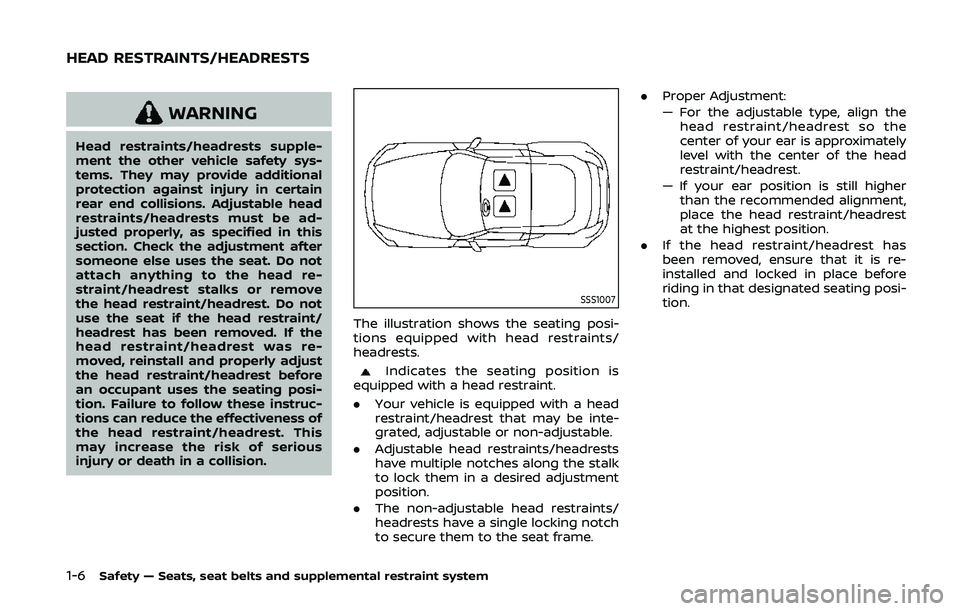
1-6Safety — Seats, seat belts and supplemental restraint system
WARNING
Head restraints/headrests supple-
ment the other vehicle safety sys-
tems. They may provide additional
protection against injury in certain
rear end collisions. Adjustable head
restraints/headrests must be ad-
justed properly, as specified in this
section. Check the adjustment after
someone else uses the seat. Do not
attach anything to the head re-
straint/headrest stalks or remove
the head restraint/headrest. Do not
use the seat if the head restraint/
headrest has been removed. If the
head restraint/headrest was re-
moved, reinstall and properly adjust
the head restraint/headrest before
an occupant uses the seating posi-
tion. Failure to follow these instruc-
tions can reduce the effectiveness of
the head restraint/headrest. This
may increase the risk of serious
injury or death in a collision.
SSS1007
The illustration shows the seating posi-
tions equipped with head restraints/
headrests.
Indicates the seating position is
equipped with a head restraint.
. Your vehicle is equipped with a head
restraint/headrest that may be inte-
grated, adjustable or non-adjustable.
. Adjustable head restraints/headrests
have multiple notches along the stalk
to lock them in a desired adjustment
position.
. The non-adjustable head restraints/
headrests have a single locking notch
to secure them to the seat frame. .
Proper Adjustment:
— For the adjustable type, align the
head restraint/headrest so the
center of your ear is approximately
level with the center of the head
restraint/headrest.
— If your ear position is still higher than the recommended alignment,
place the head restraint/headrest
at the highest position.
. If the head restraint/headrest has
been removed, ensure that it is re-
installed and locked in place before
riding in that designated seating posi-
tion.
HEAD RESTRAINTS/HEADRESTS
Page 29 of 455
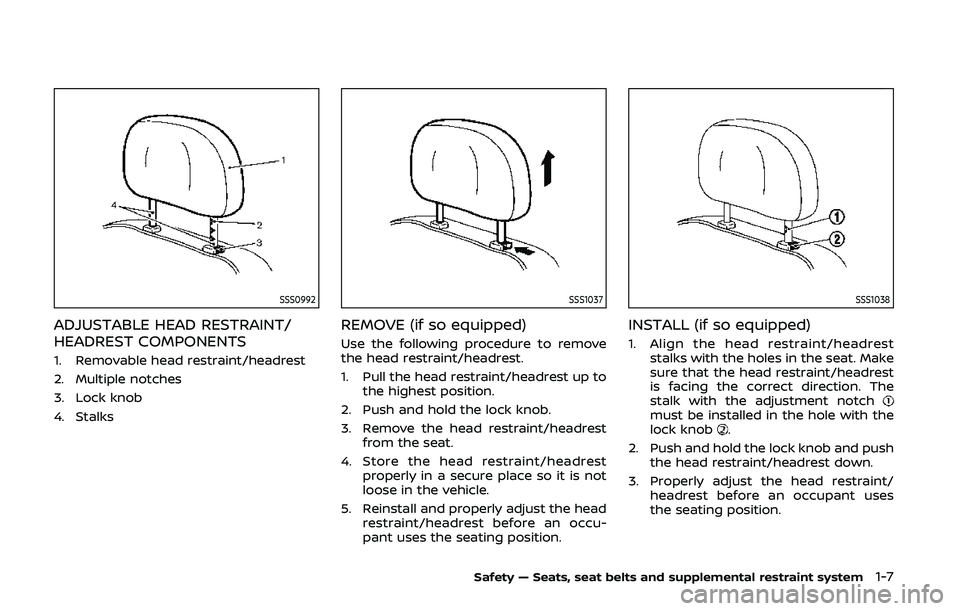
SSS0992
ADJUSTABLE HEAD RESTRAINT/
HEADREST COMPONENTS
1. Removable head restraint/headrest
2. Multiple notches
3. Lock knob
4. Stalks
SSS1037
REMOVE (if so equipped)
Use the following procedure to remove
the head restraint/headrest.
1. Pull the head restraint/headrest up tothe highest position.
2. Push and hold the lock knob.
3. Remove the head restraint/headrest from the seat.
4. Store the head restraint/headrest properly in a secure place so it is not
loose in the vehicle.
5. Reinstall and properly adjust the head restraint/headrest before an occu-
pant uses the seating position.
SSS1038
INSTALL (if so equipped)
1. Align the head restraint/headreststalks with the holes in the seat. Make
sure that the head restraint/headrest
is facing the correct direction. The
stalk with the adjustment notch
must be installed in the hole with the
lock knob.
2. Push and hold the lock knob and push the head restraint/headrest down.
3. Properly adjust the head restraint/ headrest before an occupant uses
the seating position.
Safety — Seats, seat belts and supplemental restraint system1-7
Page 33 of 455
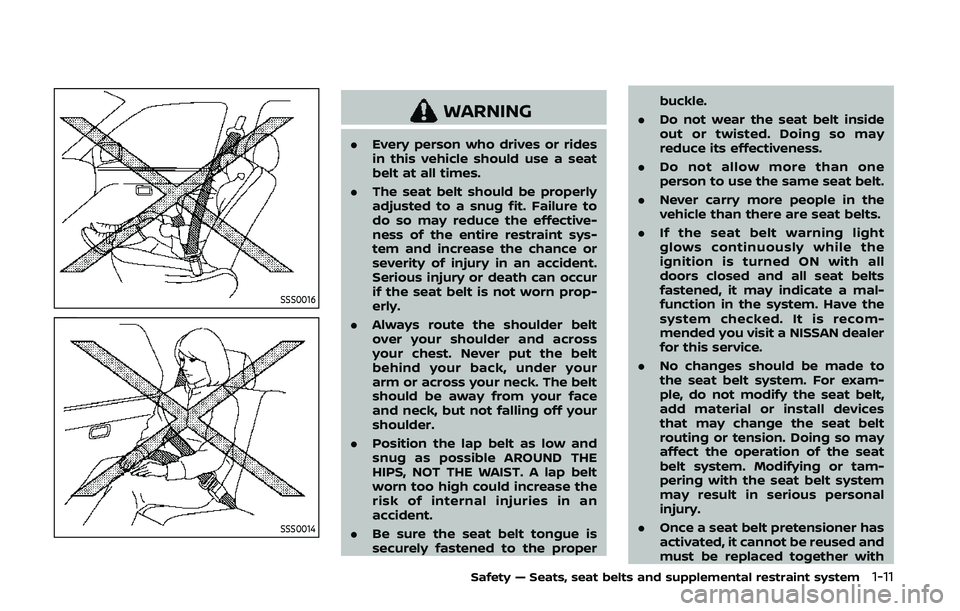
SSS0016
SSS0014
WARNING
.Every person who drives or rides
in this vehicle should use a seat
belt at all times.
. The seat belt should be properly
adjusted to a snug fit. Failure to
do so may reduce the effective-
ness of the entire restraint sys-
tem and increase the chance or
severity of injury in an accident.
Serious injury or death can occur
if the seat belt is not worn prop-
erly.
. Always route the shoulder belt
over your shoulder and across
your chest. Never put the belt
behind your back, under your
arm or across your neck. The belt
should be away from your face
and neck, but not falling off your
shoulder.
. Position the lap belt as low and
snug as possible AROUND THE
HIPS, NOT THE WAIST. A lap belt
worn too high could increase the
risk of internal injuries in an
accident.
. Be sure the seat belt tongue is
securely fastened to the proper buckle.
. Do not wear the seat belt inside
out or twisted. Doing so may
reduce its effectiveness.
. Do not allow more than one
person to use the same seat belt.
. Never carry more people in the
vehicle than there are seat belts.
. If the seat belt warning light
glows continuously while the
ignition is turned ON with all
doors closed and all seat belts
fastened, it may indicate a mal-
function in the system. Have the
system checked. It is recom-
mended you visit a NISSAN dealer
for this service.
. No changes should be made to
the seat belt system. For exam-
ple, do not modify the seat belt,
add material or install devices
that may change the seat belt
routing or tension. Doing so may
affect the operation of the seat
belt system. Modifying or tam-
pering with the seat belt system
may result in serious personal
injury.
. Once a seat belt pretensioner has
activated, it cannot be reused and
must be replaced together with
Safety — Seats, seat belts and supplemental restraint system1-11
Page 34 of 455
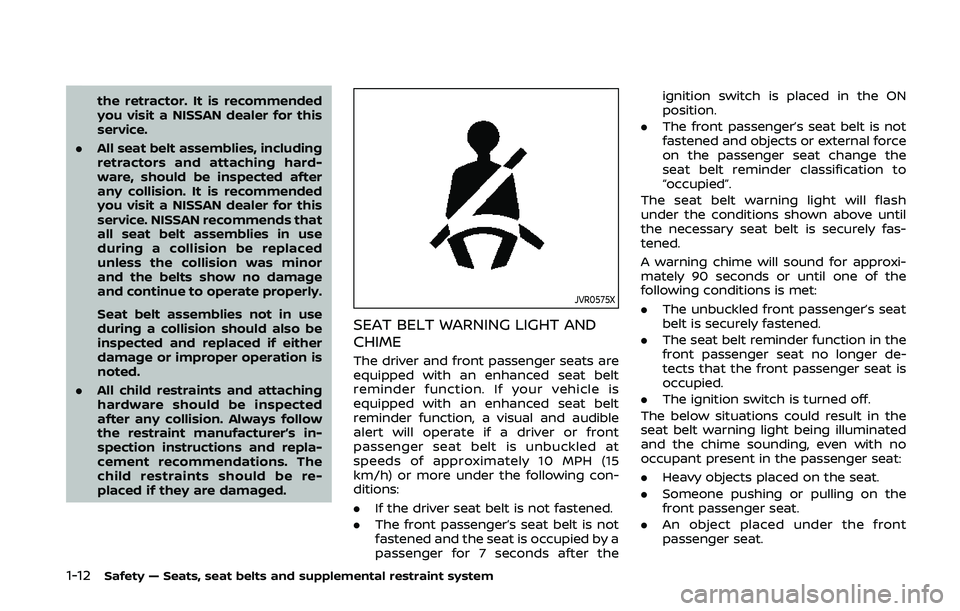
1-12Safety — Seats, seat belts and supplemental restraint system
the retractor. It is recommended
you visit a NISSAN dealer for this
service.
. All seat belt assemblies, including
retractors and attaching hard-
ware, should be inspected after
any collision. It is recommended
you visit a NISSAN dealer for this
service. NISSAN recommends that
all seat belt assemblies in use
during a collision be replaced
unless the collision was minor
and the belts show no damage
and continue to operate properly.
Seat belt assemblies not in use
during a collision should also be
inspected and replaced if either
damage or improper operation is
noted.
. All child restraints and attaching
hardware should be inspected
after any collision. Always follow
the restraint manufacturer’s in-
spection instructions and repla-
cement recommendations. The
child restraints should be re-
placed if they are damaged.
JVR0575X
SEAT BELT WARNING LIGHT AND
CHIME
The driver and front passenger seats are
equipped with an enhanced seat belt
reminder function. If your vehicle is
equipped with an enhanced seat belt
reminder function, a visual and audible
alert will operate if a driver or front
passenger seat belt is unbuckled at
speeds of approximately 10 MPH (15
km/h) or more under the following con-
ditions:
.If the driver seat belt is not fastened.
. The front passenger’s seat belt is not
fastened and the seat is occupied by a
passenger for 7 seconds after the ignition switch is placed in the ON
position.
. The front passenger’s seat belt is not
fastened and objects or external force
on the passenger seat change the
seat belt reminder classification to
“occupied”.
The seat belt warning light will flash
under the conditions shown above until
the necessary seat belt is securely fas-
tened.
A warning chime will sound for approxi-
mately 90 seconds or until one of the
following conditions is met:
. The unbuckled front passenger’s seat
belt is securely fastened.
. The seat belt reminder function in the
front passenger seat no longer de-
tects that the front passenger seat is
occupied.
. The ignition switch is turned off.
The below situations could result in the
seat belt warning light being illuminated
and the chime sounding, even with no
occupant present in the passenger seat:
. Heavy objects placed on the seat.
. Someone pushing or pulling on the
front passenger seat.
. An object placed under the front
passenger seat.
Page 37 of 455
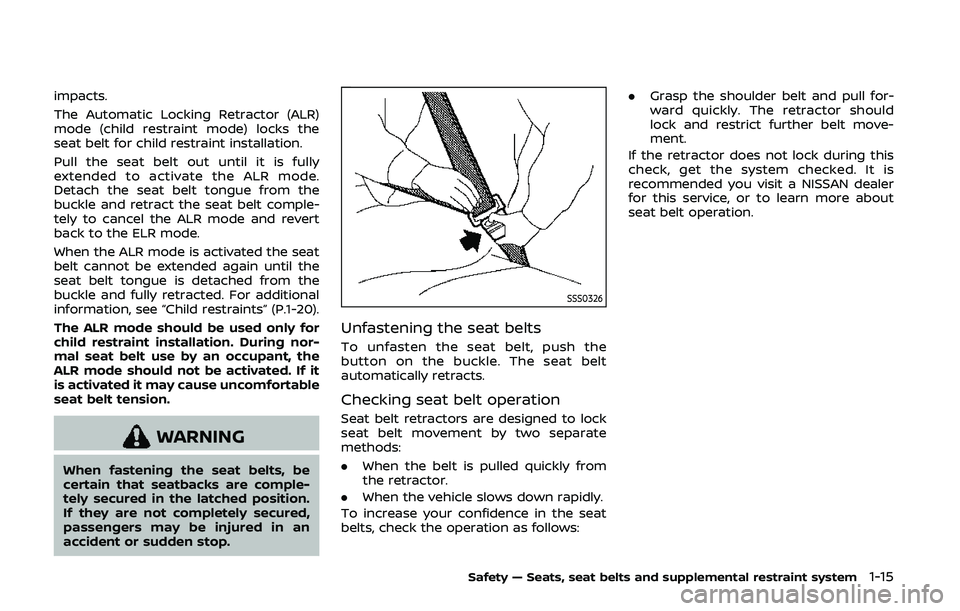
impacts.
The Automatic Locking Retractor (ALR)
mode (child restraint mode) locks the
seat belt for child restraint installation.
Pull the seat belt out until it is fully
extended to activate the ALR mode.
Detach the seat belt tongue from the
buckle and retract the seat belt comple-
tely to cancel the ALR mode and revert
back to the ELR mode.
When the ALR mode is activated the seat
belt cannot be extended again until the
seat belt tongue is detached from the
buckle and fully retracted. For additional
information, see “Child restraints” (P.1-20).
The ALR mode should be used only for
child restraint installation. During nor-
mal seat belt use by an occupant, the
ALR mode should not be activated. If it
is activated it may cause uncomfortable
seat belt tension.
WARNING
When fastening the seat belts, be
certain that seatbacks are comple-
tely secured in the latched position.
If they are not completely secured,
passengers may be injured in an
accident or sudden stop.
SSS0326
Unfastening the seat belts
To unfasten the seat belt, push the
button on the buckle. The seat belt
automatically retracts.
Checking seat belt operation
Seat belt retractors are designed to lock
seat belt movement by two separate
methods:
.When the belt is pulled quickly from
the retractor.
. When the vehicle slows down rapidly.
To increase your confidence in the seat
belts, check the operation as follows: .
Grasp the shoulder belt and pull for-
ward quickly. The retractor should
lock and restrict further belt move-
ment.
If the retractor does not lock during this
check, get the system checked. It is
recommended you visit a NISSAN dealer
for this service, or to learn more about
seat belt operation.
Safety — Seats, seat belts and supplemental restraint system1-15
Page 38 of 455
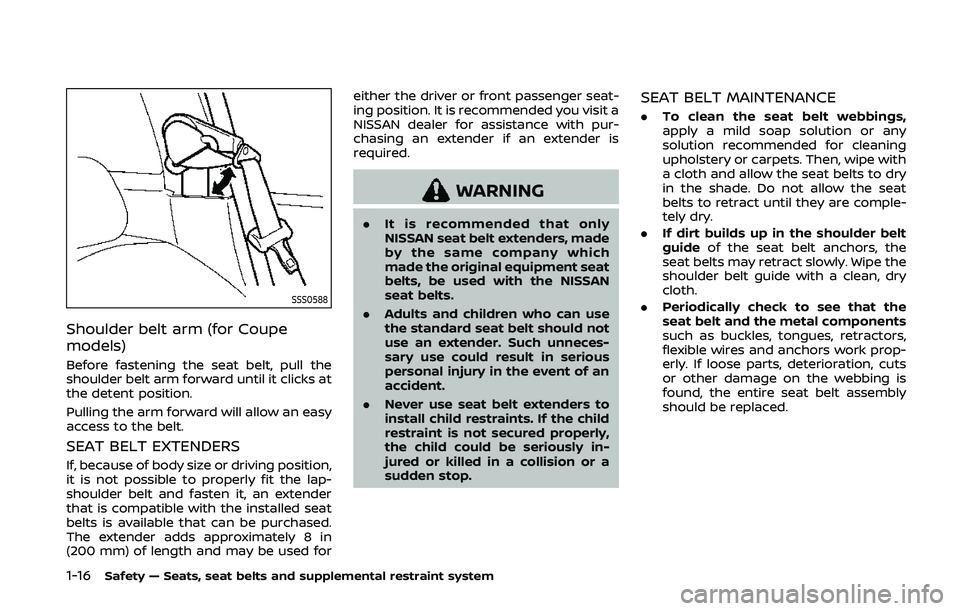
1-16Safety — Seats, seat belts and supplemental restraint system
SSS0588
Shoulder belt arm (for Coupe
models)
Before fastening the seat belt, pull the
shoulder belt arm forward until it clicks at
the detent position.
Pulling the arm forward will allow an easy
access to the belt.
SEAT BELT EXTENDERS
If, because of body size or driving position,
it is not possible to properly fit the lap-
shoulder belt and fasten it, an extender
that is compatible with the installed seat
belts is available that can be purchased.
The extender adds approximately 8 in
(200 mm) of length and may be used foreither the driver or front passenger seat-
ing position. It is recommended you visit a
NISSAN dealer for assistance with pur-
chasing an extender if an extender is
required.
WARNING
.
It is recommended that only
NISSAN seat belt extenders, made
by the same company which
made the original equipment seat
belts, be used with the NISSAN
seat belts.
. Adults and children who can use
the standard seat belt should not
use an extender. Such unneces-
sary use could result in serious
personal injury in the event of an
accident.
. Never use seat belt extenders to
install child restraints. If the child
restraint is not secured properly,
the child could be seriously in-
jured or killed in a collision or a
sudden stop.
SEAT BELT MAINTENANCE
. To clean the seat belt webbings,
apply a mild soap solution or any
solution recommended for cleaning
upholstery or carpets. Then, wipe with
a cloth and allow the seat belts to dry
in the shade. Do not allow the seat
belts to retract until they are comple-
tely dry.
. If dirt builds up in the shoulder belt
guide of the seat belt anchors, the
seat belts may retract slowly. Wipe the
shoulder belt guide with a clean, dry
cloth.
. Periodically check to see that the
seat belt and the metal components
such as buckles, tongues, retractors,
flexible wires and anchors work prop-
erly. If loose parts, deterioration, cuts
or other damage on the webbing is
found, the entire seat belt assembly
should be replaced.
Page 39 of 455
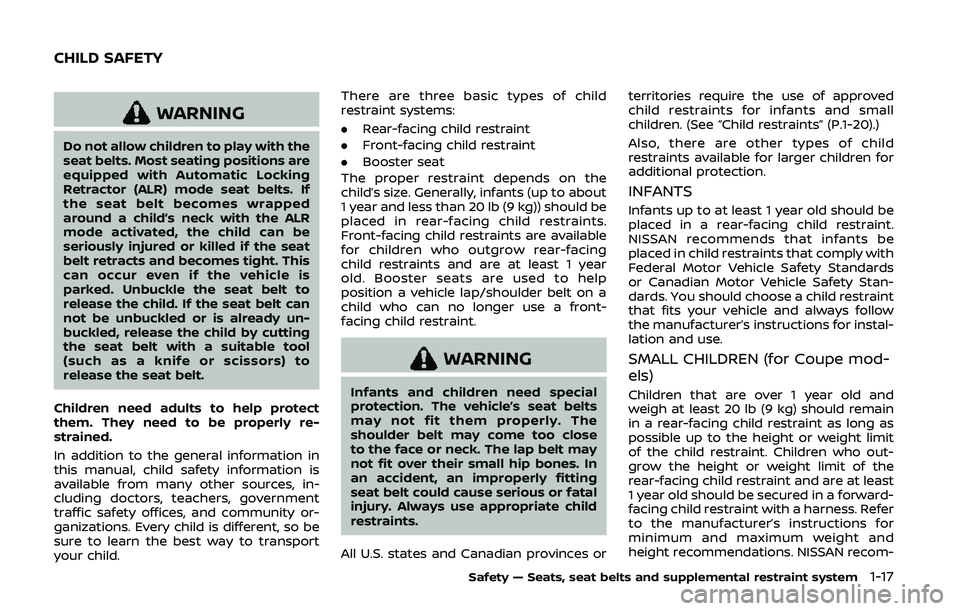
WARNING
Do not allow children to play with the
seat belts. Most seating positions are
equipped with Automatic Locking
Retractor (ALR) mode seat belts. If
the seat belt becomes wrapped
around a child’s neck with the ALR
mode activated, the child can be
seriously injured or killed if the seat
belt retracts and becomes tight. This
can occur even if the vehicle is
parked. Unbuckle the seat belt to
release the child. If the seat belt can
not be unbuckled or is already un-
buckled, release the child by cutting
the seat belt with a suitable tool
(such as a knife or scissors) to
release the seat belt.
Children need adults to help protect
them. They need to be properly re-
strained.
In addition to the general information in
this manual, child safety information is
available from many other sources, in-
cluding doctors, teachers, government
traffic safety offices, and community or-
ganizations. Every child is different, so be
sure to learn the best way to transport
your child. There are three basic types of child
restraint systems:
.
Rear-facing child restraint
. Front-facing child restraint
. Booster seat
The proper restraint depends on the
child’s size. Generally, infants (up to about
1 year and less than 20 lb (9 kg)) should be
placed in rear-facing child restraints.
Front-facing child restraints are available
for children who outgrow rear-facing
child restraints and are at least 1 year
old. Booster seats are used to help
position a vehicle lap/shoulder belt on a
child who can no longer use a front-
facing child restraint.
WARNING
Infants and children need special
protection. The vehicle’s seat belts
may not fit them properly. The
shoulder belt may come too close
to the face or neck. The lap belt may
not fit over their small hip bones. In
an accident, an improperly fitting
seat belt could cause serious or fatal
injury. Always use appropriate child
restraints.
All U.S. states and Canadian provinces or territories require the use of approved
child restraints for infants and small
children. (See “Child restraints” (P.1-20).)
Also, there are other types of child
restraints available for larger children for
additional protection.
INFANTS
Infants up to at least 1 year old should be
placed in a rear-facing child restraint.
NISSAN recommends that infants be
placed in child restraints that comply with
Federal Motor Vehicle Safety Standards
or Canadian Motor Vehicle Safety Stan-
dards. You should choose a child restraint
that fits your vehicle and always follow
the manufacturer’s instructions for instal-
lation and use.
SMALL CHILDREN (for Coupe mod-
els)
Children that are over 1 year old and
weigh at least 20 lb (9 kg) should remain
in a rear-facing child restraint as long as
possible up to the height or weight limit
of the child restraint. Children who out-
grow the height or weight limit of the
rear-facing child restraint and are at least
1 year old should be secured in a forward-
facing child restraint with a harness. Refer
to the manufacturer’s instructions for
minimum and maximum weight and
height recommendations. NISSAN recom-
Safety — Seats, seat belts and supplemental restraint system1-17
CHILD SAFETY